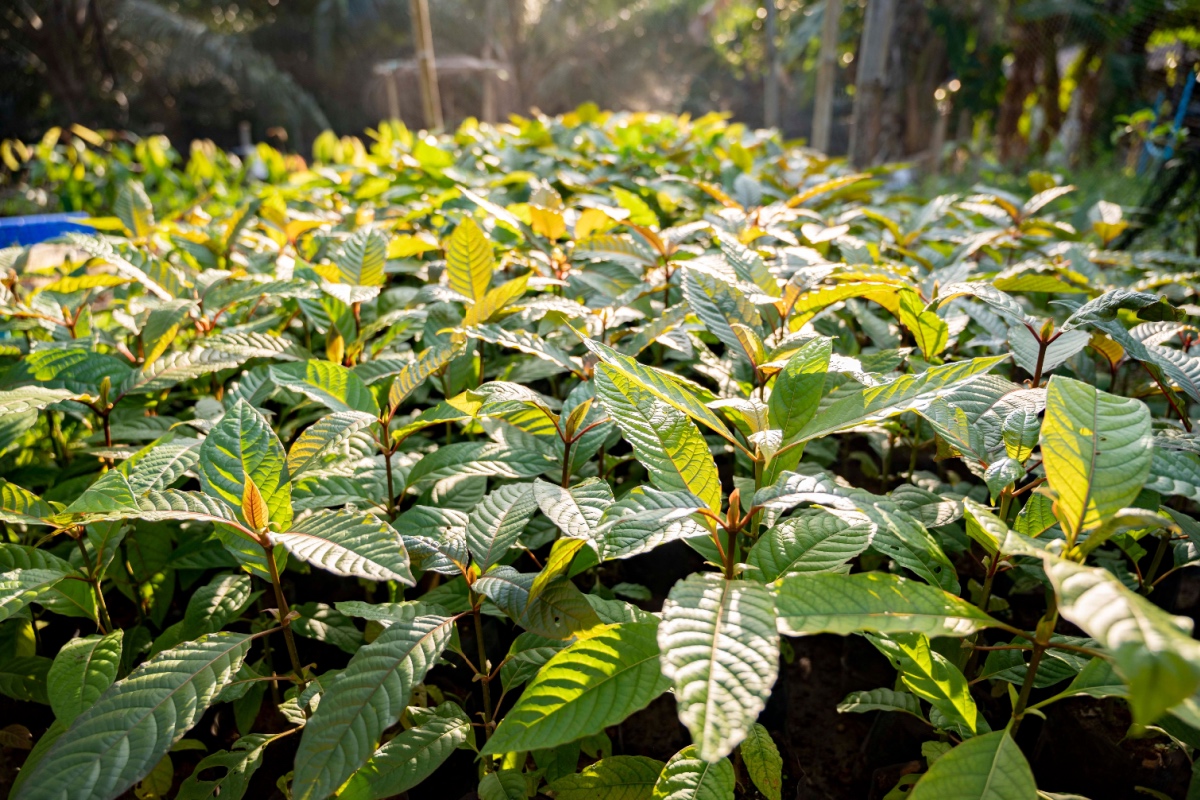The production of Kratom involves several stages: cultivation, harvesting, drying, grinding, and quality control. Each step is critical to preserving the plant’s potency and ensuring that the final product is safe for consumption.
From selecting the right environment for growing Kratom to ensuring the leaves are harvested at their peak, every phase of production requires attention to detail. Modern techniques and traditional methods blend to create a product that meets high standards of quality and effectiveness.
Cultivation of Kratom
Kratom thrives in tropical climates with high humidity and ample rainfall. It requires well-drained soil, rich in organic matter. The best regions for cultivating Kratom are Southeast Asian countries like Thailand, Malaysia, and Indonesia, where the climate and soil conditions are optimal.
The tree can grow to impressive heights, often reaching over 20 meters. Proper spacing, adequate sunlight, and regular pruning are essential practices to ensure healthy growth. The right balance of water and nutrients in the soil supports the development of leaves rich in active compounds.
Harvesting Techniques
Harvesting Kratom requires precision. The leaves are hand-picked to ensure only mature leaves are selected, as they contain the highest concentration of alkaloids. Farmers must be knowledgeable about the right time to harvest, which typically depends on the desired effect and alkaloid content.
Skilled harvesters can determine the optimal time for picking by observing the color and texture of the leaves. Proper harvesting techniques ensure that the tree remains healthy and continues to produce high-quality leaves for future harvests.
Challenges in Cultivation
Cultivating Kratom poses several challenges, including:
- Pest Control: Natural pests can affect the health of Kratom trees. Farmers must employ organic methods to protect the plants without using harmful chemicals.
- Climate Variability: Changes in weather can impact growth and yield. Excessive rainfall or prolonged drought can affect the quality of the leaves.
- Sustainability: Ensuring that farming practices do not deplete natural resources or harm the environment. Sustainable practices include crop rotation, organic fertilizers, and water conservation techniques.
Harvesting Kratom Leaves
The timing of the harvest is crucial. Leaves are usually harvested at different stages of maturity, depending on the desired alkaloid profile. For instance, older leaves tend to have higher alkaloid content, making them more potent.
Farmers must balance the timing of the harvest to ensure that the leaves reach their peak potency without overripening. This requires a deep understanding of the growth cycle and close monitoring of the plants.
Methods of Harvesting
Harvesting methods can vary, but traditional hand-picking remains the most common. This method ensures that only the best leaves are selected, preserving the quality of the product. Mechanical harvesting, although less common, is sometimes used in larger operations.
Hand-picking allows for selective harvesting, ensuring that each leaf is chosen for its quality. Mechanical harvesting, while efficient, may not offer the same level of precision and can sometimes result in a mix of mature and immature leaves.
Post-Harvest Handling
After harvesting, the leaves must be handled with care to prevent degradation. They are often washed to remove any contaminants and then sorted based on quality. Proper handling is essential to maintain the potency and purity of the leaves.
Sorting and cleaning processes help to remove any debris or damaged leaves. This step is critical to ensuring that the final product is free from impurities and meets high standards of quality.
Drying and Fermentation
Traditional drying methods involve spreading the leaves out in the sun. This method is still widely used due to its simplicity and effectiveness. Sun-drying helps to preserve the natural alkaloid content while giving the leaves a distinct aroma and flavor.
Sun-drying is a natural and cost-effective method that has been used for generations. It relies on the heat and light from the sun to gradually dry the leaves, reducing their moisture content and preparing them for further processing.
Modern Drying Techniques
Modern techniques include controlled drying environments, such as dehydrators or climate-controlled rooms. These methods provide more consistency and control over the drying process, ensuring a uniform product.
Controlled drying environments allow for precise regulation of temperature and humidity. This consistency helps to produce a high-quality product with predictable effects, making it more reliable for consumers.
Fermentation Process
Some Kratom leaves undergo a fermentation process to alter their alkaloid profile. This process involves placing the leaves in bags or containers to allow them to ferment for a specific period. The result is a change in color and effects, often producing a red variety with different properties.
Fermentation can enhance certain alkaloids, giving the leaves unique properties. This process is carefully monitored to achieve the desired balance of compounds, resulting in a product that offers distinct benefits compared to non-fermented leaves.
Grinding and Processing
Kratom is available in various forms to suit different preferences. The most common forms include:
- Powder: Made by grinding dried leaves into a fine powder. This form is versatile and can be used in various ways, such as in teas or smoothies.
- Capsules: Convenient and easy to consume, filled with Kratom powder. Capsules provide a consistent dosage and are discreet and portable.
- Extracts: Concentrated forms of Kratom that provide more potent effects. Extracts are made by isolating the active compounds and are often used by those seeking stronger effects.
Each form of Kratom offers unique benefits and can be chosen based on personal preferences and desired effects.
Grinding Techniques
Grinding is a critical step that affects the texture and consistency of the final product. High-quality grinders ensure that the powder is fine and free of any impurities. This step is essential for both powdered and encapsulated Kratom products.
Modern grinding techniques involve high-speed grinders that produce a uniform powder. This uniformity ensures that the product is consistent in potency and easy to use in various applications.
Processing for Consistency
Consistency in processing is vital to ensure that each batch of Kratom maintains the same quality and potency. This involves careful measurement and mixing to create a uniform product. Consistent processing helps build trust with consumers who rely on the product’s effectiveness.
Producers use standardized processes to ensure that each batch meets strict quality criteria. This consistency is crucial for consumer confidence and satisfaction.
Packaging and Storage
Proper packaging and storage are crucial to preserving the quality of Kratom. The products are usually packaged in airtight containers to prevent exposure to air and moisture, which can degrade the alkaloids. Cool, dark storage conditions are ideal for maintaining potency over time.
Packaging also includes clear labeling with important information such as dosage recommendations, batch numbers, and expiration dates. Proper storage practices help to extend the shelf life of the product and ensure that it remains effective.
Quality Control
Quality control begins with rigorous testing for purity and contaminants. This includes testing for heavy metals, pesticides, and microbial contamination. Ensuring the product is free from harmful substances is essential for consumer safety.
Testing laboratories use advanced techniques to detect even trace amounts of contaminants. Regular testing helps to ensure that each batch of Kratom meets high safety standards.
Certification Standards
Adhering to certification standards, such as GMP (Good Manufacturing Practices), helps maintain high-quality production. Certification provides assurance to consumers that the product meets industry standards and is produced under strict guidelines.
Certification also involves regular inspections and audits by independent bodies. This oversight helps to maintain transparency and accountability in the production process.
Consumer Safety Measures
Safety measures include clear labeling of products, providing dosage recommendations, and offering information on potential side effects. Transparent communication helps consumers use Kratom responsibly and safely.
Producers also provide educational resources to help consumers understand how to use Kratom effectively and safely. This includes information on dosage, potential interactions with other substances, and recognizing signs of adverse effects.
Maintaining Industry Standards
Maintaining high industry standards is crucial for the reputation of Kratom producers. Continuous monitoring, regular audits, and adherence to best practices ensure that the product remains of high quality and safe for consumption.
Producers work closely with industry organizations to stay updated on best practices and regulatory changes. This collaboration helps to promote a safe and responsible Kratom market.
Importance of Understanding Kratom Production
The production of Kratom involves several meticulous steps, from cultivation to quality control. Each stage is crucial to ensuring the final product is potent, safe, and ethically sourced.
From selecting the right growing conditions to ensuring the leaves are processed and packaged correctly, every step plays a vital role in delivering a high-quality product. Understanding this process helps consumers appreciate the effort and care that goes into producing Kratom.
If you’re looking for high-quality Kratom products, look no further than Urban Ice Botanicals. Our commitment to quality ensures that you receive the best Kratom available. Explore our range of Kratom products today!
FAQs
- What is Kratom?
Kratom is a tropical tree native to Southeast Asia, known for its leaves that can have psychotropic effects.
- How is Kratom harvested?
Kratom leaves are hand-picked to ensure only mature leaves with high alkaloid content are selected.
- What are the different types of Kratom products?
Kratom is available in various forms, including powder, capsules, and extracts.
- How can I ensure the quality of Kratom I purchase?
Look for products that adhere to certification standards, such as GMP, and provide clear information about testing for purity and contaminants.
- What are the environmental impacts of Kratom farming?
Sustainable farming practices are essential to minimize environmental impact, including conserving water and protecting natural habitats.





